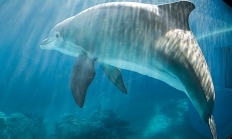Search myodfw.com
The Northern grasshopper mouse is a stockily built mouse with a thick tail. The dorsal pelage is dark sepia long the midline grading moderately sharply to a light tannish along the sides. The ventral pelage is white. A dark sepia line extends across the face between the eyes. The ears are thinly furred, sepia on the external surface and light grayish-tan on the internal surface. The feet and tip of the tail are white. In Oregon, Northern grasshopper mice have been found in grassland and desert areas in Crook, Deschutes, Gilliam, Harney, Jefferson, Klamath, Lake , Malheur, Morrow, Sherman, Umatilla
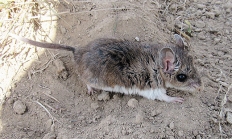
The white-footed vole is among the smaller voles. The pelage consists of dark bluish-gray hairs tipped with a rich brown or black on the dorsum grading lighter on the sides, thence to light gray to pinkish buff on the venter. The tail is distinctly bi-colored: white or buff on the vental surface, brownish black on the dorsal surface. The dark dorsal stripe is much wider than the lighter ventral stripe. The feet are light grayish. This vole occurs from Old Fort Clatsop, Clatsop county, and near Rainier, Columbia County, south through the coast range. Various Oregon specimens have been found
The montane vole is a medium-sized vole. The pelage is ashy gray mixed with brown and black on the dorsum shading to light gray or whitish on the venter. The feet are lead colored and the tail is bi-colored black or dark gray above and light gray to whitish below. Splotches of different shades of yellow on the nose, venter, and dorsal surfaces of the feet and tail occur on some adult Montane voles. This vole is distributed throughout most montane and intermontane areas of the west occurring throughout that portion of Oregon east of the crest of the Cascade
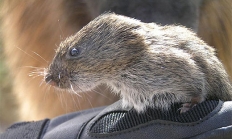
Features: Coastal cutthroat trout are typically are blue/green on top, red along the lateral line, and white on the belly. They are lightly or heavily spotted and adults have a red slash mark on the throat. Habitat: The most common variety of trout in Oregon is the coastal cutthroat, found in the streams and beaver ponds in coastal drainages. They also are stocked in high mountain hike-in lakes where the water stays cool throughout the summer. Techniques: Cutthroats that are year-round residents of small streams may not get any bigger than 8- or 9-inches, but can reward the angler with
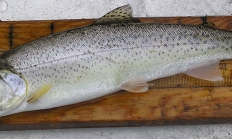
The northwest zone provides many opportunities for crabbing and clamming. This zone encompasses Clatsop beaches, Nehalem Bay, Tillamook Bay, Netarts Bay, Nestucca Bay, Siletz Bay, Yaquina Bay, Alsea Bay and Siuslaw River.
This largest of the commonly encountered loons is perfectly built for underwater prey pursuit. Ungainly on land, this may be the price it pays for being a great diver. Large and blocky-headed, with a straight, robust bill, the common loon is separated from the yellow-billed by its straight bill and winter face pattern, and from smaller loons by its more angular head and often-retracted robust neck. Black head, white "necklace," incomplete black-and-white neckband, and white-checkered black back define breeding adults. Dark gray upperparts of winter adults shade to white underparts. Take-off is impossible by land and labored on water, but

Swainson's hawks are medium-sized buteos, smaller than Red-tailed and Ferruginous hawks. Plumage beneath varies along a continuum from very pale to nearly black below. Lighter-plumaged birds have a distinct chest band. They have relatively long, pointed wings that contribute to superior flying skills. The dark flight feathers contrast with paler wing lining in all but the darkest birds. It breeds in the bunchgrass prairies east of the Cascades with the highest concentration in the foothills of the Blue and Wallowa mountains. It prefers open country and has little need for numerous trees since it forages extensively while in flight and

This is the world's smallest "peep" and can usually be picked out by its brownish coloration, dull yellowish legs, and hunched, creeping foraging style. Least can be found in small flocks in Oregon almost year-round. The Least sandpiper feeds on open mud with Western sandpipers but often feeds where some grass, salicornia or other cover is present, avoiding walking in the water as Western often do. It is uncommon to locally abundant statewide in migration, with most birds along the coast and at larger lakes and marshes inland. It is locally common on the coast in winter; smaller numbers winter

These small, fast flying seabirds are unique among alcids in North America in their use of coastal coniferous forests, primarily old-growth trees, as nesting habitat. Their solitary nests are usually concealed within the forest canopy, and breeding birds are cryptic and primarily crepuscular at nest sites. Because of their secretive behavior and elusive nests, Marbled murrelets were considered the "enigma of the Pacific" and were one of the last ornithological mysteries in North America, as the first nest was not discovered until 1974. Distribution at inland nesting sites is fragmented, as birds occur only in areas where suitable habitat remains

On his historic expedition with Meriwether Lewis, Captain William Clark, the bird's namesake, first mistook this species for a woodpecker undoubtedly because of its long, sharp beak. However, this most specialized member of the North American Crow family uses this apparatus to pry loose its favored seeds from unrelenting cones of several pines with which the nutcracker has a symbiotic relationship. The whitebark pine, in particular, is totally reliant on Clark's nutcrackers for seed dispersal and germination. In Oregon the Clark's nutcracker is a resident along the crest of the Cascades, usually above 4,000 feet, lower on the east slope

The Red-breasted nuthatch is a happy, jolly little bird, quick and agile in its motions and seemingly always in a hurry to scramble over the branches. It is distinguished from other nuthatches by white eyebrows, black eyelines and cap, reddish breast, and nasal yank yank song. Although males have a blacker cap and redder breast than females, distinguishing sexes in the field is difficult. During winter, is can be observed foraging in mixed-species flocks with Chickadees, Brown creepers, Kinglets, Townsend's carblers, and Dark-eyed junkos. The Red-breasted nuthatch breeds and winters throughout Oregon where conifer or mixed conifer-hardwood forests are present
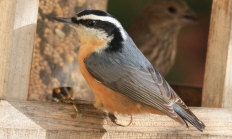
These large salamanders are marbled brown and tan in color when in their rare terrestrial (land-living) adult form. They are brown with yellowish-tan patches on These large salamanders have an aquatic adult stage that is brown with yellowish-tan patches and short gills. The rare terrestrial adult is marbled brown and tan. Larvae of Cope’s giant salamander are smaller with a more narrow head and shorter legs than the coastal giant salamander. Both terrestrial and aquatic adults can grow up to eight inches in total length. Most adult salamanders live in cold, fast-flowing, clear and permanent streams in coniferous forests. Adult

Adult clouded salamanders are generally brown with brassy patches on their backs and gray bellies. As salamanders age, the brassy color fades. The clouded salamander is one of the lungless salamander species; they breathe through their moist skin. Mature adults can grow to just over five inches in total length. Clouded salamanders prefer forest habitats or burned areas that provide large decaying logs or stumps. They are often found in Douglas fir trees where they can find burrows in the wood, or spaces just under the bark to hide. They may also hide deep in rock crevices during dry and

These large toads are well camouflaged in earth tones with dry bumpy skin that aids in protection from predators. Their color can be highly variable among individuals ranging from gray or reddish-brown to yellow or green. They have a light colored stripe that runs along the center of the back. Adult female toads are larger than males, growing to five inches in length. They live mainly on land in a range of habitats from forests to mountain meadows to desert flats. During the non-breeding season, they are nocturnal. They dig their own burrows in loose soil, use existing burrows or

This restless diver of cold oceans and bays is one of the prize waterfowl to see on a coastal winter day. Although the loud, musical call of males is seldom heard in Oregon, we can still be cheered on a chilly day by this energetic visitor from the north. The winter males' body is mostly white except for a black breast and central back; the wings are dark, scapulars long and gray, and the dark central tail feathers elongate. Winter females are darker above with a light head; scapulars and tail feathers are short and dark. Dark areas mark females'

The House sparrow is an invasive species introduced from Europe. No other North American wild bird is so associated with human settlement as this introduced House sparrow. Its foods are nearly all imports, and its nesting and cover requirements are also human-derived. The House sparrow and European starling are the only introduced passerine birds that are thriving in Oregon. These birds can dominate bird feeders and utilize nest boxes that were intended for native species. The House sparrow can be found statewide around buildings at human developments of adequate size ranging from scattered farmsteads in remote and rural areas to

The Townsend's vole is a large vole with large ears that extend above the fur, a long brownish or blackish tail and brownish or blackish feet equipped with brown claws. In Oregon, it has been found along the Pacific Coast south to southern Coos County, throughout the Willamette Valley with eastward extensions along the Columbia River to near Hood River; the McKenzie River to Douglas County; and the Rogue River to Prospect, Jackson County. With few exceptions, Townsend's vole is associated with moist habitats: meadows, lowland pastures, riparian zones, boggy lands, marshes, and irrigated fields densely vegetated with grasses and
The Western spotted skunk is smaller and more weasel-like than the Striped skunk. The pelage is black with a somewhat pentagonal white patch between the eyes, a round white patch on each side of the head and four or six segmented white body stripes. This skunk is endowed with a muscle-encapsulated musk gland similar to those of the Striped skunk and so similarly, can eject musk from two papillae located under the tail. The odor of the musk is considered somewhat more pungent or acrid but is less spreading than that of the Striped skunk. In Oregon, this skunk occurs

The bottlenose dolphin is the most common of the oceanic dolphins and can be found in all tropical and temperate oceans. Flipper was a bottlenose dolphin. Their considerable intelligence and permanently-affixed smile make them a favorite of aquarium and television shows. The U.S. Navy also uses bottlenose dolphins to find mines and booby traps underwater. Oregon is the northern extent of its range on the West Coast. They are most often seen offshore during the summer by tuna and other fishers. They are gray with light gray to white on the undersides. In size they range from six to 13
